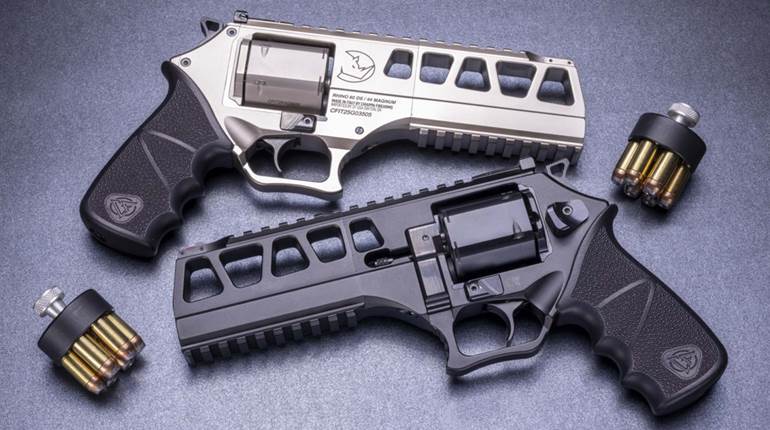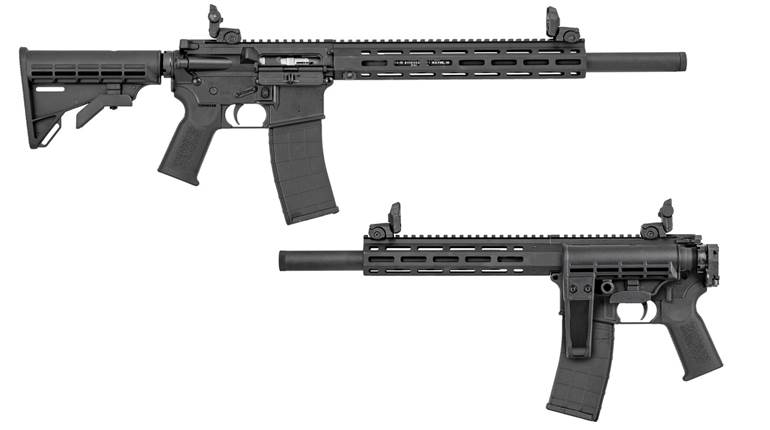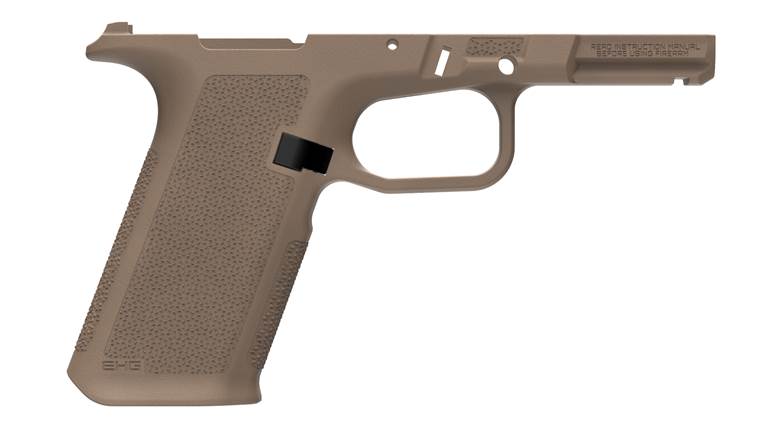
Apprentice Darrin McDonal cranks the flywheel of the reaming machine as master gunsmith Richard Sullivan pushes a barrel into the boring bit at the gunsmith shop in Colonial Williamsburg.
It would be easy to miss the tiny structure nestled in the shadows of the imposing brick Capitol Building on the edge of Colonial Williamsburg—a living-history section of the former Virginia capital. The only external clue to its purpose is the sign over the door—two crossed rifles and a powder keg with the word “GunSmith” underneath them.
In the yard, a crowd has formed around two men who send a shower of sparks in their direction as the pair pound on a glowing piece of iron. Master gunsmith Richard Sullivan and apprentice Eric von Aschwege are making a barrel. The flat, wrought iron “skelp,” 3/8" thick by 4" wide, is heated in the forge until white hot and then taken to the anvil-mounted swage block where hammer blows fold it around a steel mandrel. As the edges of the metal meet, they are fused together to form a barrel tube. During the forging process, the basic shape of the barrel will be formed from its flat-sided octagonal shape (a purely aesthetic feature that in the 18th century signified that a firearm was rifled) to its “swamped” profile (flared at the breech end for strength, at the muzzle end for balance and narrowed in between to save weight).
“Forging a barrel is not complex, but it takes skill and judgment,” explained Colonial Williamsburg master blacksmith and Director of Historic Trades and Skills Ken Schwarz as we watch Sullivan and von Aschwege work. “Welding is a real art that involves careful judgement of temperature and then quick work with a hammer.”

It’s as if a conversation is taking place, transmitted through the hammer, between gunsmith and the slowly forming barrel. The iron is heated to about 2,600o F, but there is no thermometer to indicate to the gunsmith when it has reached that point. He gauges the temperature by the color of the iron and the color of the sparks that fly when his hammer strikes it. The barrel is brought from the forge, given a few quick blows before it cools and returned to the coals.
Don’t let the 18th century clothing fool you. The three men in the Colonial Williamsburg gunsmith shop—Sullivan, von Aschwege and Darrin McDonal—aren’t actors. They aren’t portraying characters at a theme park. They are experienced craftsmen, working with period tools under historic conditions, who choose to demonstrate their trade in front of an audience.
“Sometimes we have a hard time convincing people that we are really doing all this work,” Sullivan said. “The rifles we make have handmade screws. If it’s a black metal part of the gun, it’s shaped by hammering. There is a phenomenal 18th century advertisement in which a gunsmith says he was ‘ready and willing to make a rifle gun that is barrel, lock and mountings from the bar, the stock from the tree.’ And that’s how we make a gun here.”
“People today are so detached from handwork, to think that you can make something that is beautiful, functional and precise using a hammer, a saw, a file and a chisel just baffles a modern audience,” Schwarz noted.

A Bar Of Iron, A Plank Of Wood & Scrap Brass
When “building” a modern rifle often means torquing a barrel nut and tapping a few roll pins into place, this pile of anonymous raw materials doesn’t look like much, but hundreds of man-hours later a Colonial Williamsburg gunsmith will have crafted these basic ingredients into an elegant flintlock American longrifle. Also known as the “Pennsylvania” or “Kentucky” rifle, the American longrifle was an amalgamation of the short and robust continental Jäeger and the long, slender English fowling piece. It was a design adapted to the requirements of surviving on the American frontier. In his book Firearms In Colonial America, M.L. Brown called the American rifle “the first major technological innovation produced in North America.” Colonial-era gunsmiths developed a defining piece of technology that would play an iconic role in this country’s story. With every stroke of the hammer, every pass of the file, the gunsmiths of Colonial Williamsburg are perpetuating the art of handmaking the American rifle.
From its beginnings in the 1920s, Colonial Williamsburg sought not only to preserve the architecture and artifacts of the historic city, but also the activities of the people who had lived there. As buildings were restored to their Colonial grandeur and cars on the street were replaced by horse-drawn carriages, the city was populated with artisans and craftspersons who began to revive historic trades. From silversmiths crafting fine tableware to cabinetmakers building ornate furniture, 18th century industry was re-born in Colonial Williamsburg’s “living museum.”

Only trades that were present in historic Williamsburg are allowed to take place there now. In 1717, London-trained gunsmith John Brush established a shop in the city, followed in the 1730s by James Geddy and his sons, David and William. A 1751 advertisement for the Geddy brothers noted their services included “Guns and Pistoles Stocks, plain or neatly varnished, Locks and Mountings, Barrels blued, bored and rifled … .” Before the innovation of interchangeable parts, gunsmiths were critical for the repair of firearms. Every sporting gun was unique, and martial arms, though built to a standard “pattern,” also had their final assembly and fitting done by hand. This meant that when a firearm broke, it wasn’t a matter of pulling an identical part from a bin and installing it; the hands of a skilled craftsmen were required.
The modern history of gunsmithing in Williamsburg begins with the name Wallace Gusler. A self-taught gunsmith from southwestern Virginia, Gusler was recruited to Colonial Williamsburg in 1962, opening the gunsmith shop there the following year. He immediately set about to re-create the Colonial-era American rifle using the materials, tools and techniques of that time period. Since there was little written evidence about how early American gunsmiths worked, Gusler reverse engineered the process, disassembling many original firearms as he searched for clues as to how they had been made, and talking to old-time gunsmiths who still had memories of handmaking rifles.
The central task was to figure out how to make the barrel, a skill that high-quality and affordable factory-made barrels had long since pushed into obscurity by the mid-20th century. Gusler successfully hand forged his first barrel in 1965 and used it later that same year to produce the first rifle for which he had made every single part himself. A few years later, the entire process was captured in “The Gunsmith of Williamsburg,” part of a film series that documented the traditional trades.
The gunsmithing program at Colonial Williamsburg works not only to preserve the form of the American longrifle, but also the tools, techniques and the working conditions under which they were originally made. Rifles are built in painstaking detail, down to the pins and screws, using period tools often made by the gunsmiths themselves. The tools and machines run on human power. The work day starts and stops with the sun, and artificial lighting comes in the form of a candle.

Inside The Gunsmith Shop …
Making the barrel is the most physically demanding and time-consuming part of the process. At the reaming machine, Sullivan pushes the barrel onto a bit powered by a large fly wheel that is being fervently cranked by McDonal. Incrementally, 1/64" at a time, the barrel’s bore is established by successively larger bits. If necessary, the barrel is straightened cold, by putting it in a vice and tweaking it slightly against a straightening jig.
Standing by the rifling machine, Sullivan explained the next step in the process. This time the barrel is fixed. A hand-carved rifling guide that looks like a giant rifle bore turned inside out directs the spiral pattern of the cutting teeth. The rifling is cut one groove with each pass, then the cutting teeth are shimmed and the process starts all over again until the desired groove depth is accomplished. A breech plug is forged to cap one end of the barrel and a touchhole drilled. The finished barrel is secured to a plank and tested with a quadruple charge of blackpowder.

With the forge still hot from barrel making, von Aschwege and McDonal prepare to cast brass. The rifle’s trigger guard and buttplate are sand-cast. An original piece is placed between two halves of a sand-filled box. The impressions they leave in the sand become the mold. The pieces of scrap brass (the British wouldn’t allow the Colonists to import the raw metal) are melted down in a crucible, and the gunsmiths take care to pour the boiling metal before all its zinc burns off in a toxic vapor. Von Aschwege removes the graphite crucible from the forging fire with a set of tongs and rushes behind the building to pour the margarine yellow molten metal into the sand mold. Instantly, the brass begins to harden, and, within an hour, the box is taken apart and the sand mold crumbles to reveal the rough castings.
It would be hard to find another craft with such extremes—from the heavy blows of the smithing hammer against an unrecognizable lump of metal in the heat and sweat of the forge to the gentle tapping of the chasing hammer, guided by the finest motor skills, as it pushes the narrow tip of an engraving chisel to put the final touches on a rifle. The Colonial-era gunsmith was not a jack-of-all-trades, but a master of many. He was blacksmith, founder, cabinetmaker and chemist, all rolled into one.

“Four hundred hours” is the generic answer that the Colonial Williamsburg gunsmiths give when the inevitable question, “How long does it take to build a rifle?” comes up, but they are working in what Sullivan calls “museum time.” Educating the public is as important as production output. Several times a day each gunsmith in the shop sets his work aside to take a turn answering visitors’ questions. This means those 400-odd hours are usually spread out over the course of a year.
Demand is high for these Colonial Williamsburg-produced firearms, which command five-figure prices, and the waiting list is backed up a decade. But more important than the firearms being made in the gunsmith shop is the knowledge that is being perpetuated and passed on to a new generation of gunsmiths. The trades practiced at Colonial Williamsburg work on the apprenticeship model. The masters in each craft teach their skills to their apprentice assistants, who eventually move on as journeymen or become masters themselves. Sullivan is the fourth master gunsmith in the program’s 55 years, and there have been dozens who refined their skills there and then moved around the country to influence the contemporary longrifle-making scene.
“The trades we practice here at Colonial Williamsburg are not something you can learn from a textbook. It’s like learning to cook, learning to play a musical instrument or learning a sport. You hook up with a mentor and learn by doing,” explained Schwarz, who supervises the historic trades in addition to his time spent at the forge.

With the barrel completed, the other metal parts of the rifle begin to take shape. The lock is made by hand, each piece forged and then filed and fitted to match the precision of a fine watch. As the parts of the rifle are assembled, their relation to each other forms its own symmetry. The stock pattern is carefully traced onto a maple blank and sawn into its basic shape. The barrel is set in the stock, the lock is positioned based on the barrel’s touch hole and the trigger mounted in relationship to the lock mechanism. The buttplate and nose piece anchor both ends of the layout. Countless hours of filing, polishing, carving and engraving will give the rifle its final form.
The result is what longrifle scholar Joe Kindig, Jr., called “a purely American work of art, a thing of beauty.” The sample rifle laying on the counter of the Colonial Williamsburg gunsmith shop has its surface worn smooth and shiny by the thousands of hands that, over the decades, have traced its lines, picked it up to feel its balance and marveled at the hands that produced it. At Colonial Williamsburg, those hands belong to men standing right behind the counter, preserving the history and heritage of gunmaking in America by living it each day, and in the process, reminding us that a rifle can be still be built one piece at a time.
To see other guns from the Willamsburg collection, which consists of more than 500 arms, visit americanrifleman.org/williamsburg.

Learning History With A Bang–Firing A Musket At Colonial Williamsburg
“But why did they just stand in lines and take turns shooting at each other?” The question invariably comes up whenever someone watches a period movie or sees their first re-enactment of an 18th century battle. The answer lies with the flintlock musket—you can’t understand the history without understanding the technology.
For two centuries the smoothbore flintlock musket ruled the battlefield. From the expansion of the European empires to the American Revolution to the formation of the modern Western world on the Napoleonic battlefields, the flintlock musket helped define history. And to understand this history you must understand the flintlock musket. To understand the flintlock musket you must handle and fire one. For those who seek this experience, Colonial Williamsburg offers the opportunity.
The Colonial Williamsburg experience is all about immersing yourself in a historical context that you not only see, but also feel, smell and taste. Along these lines, in 2016 it inaugurated its “Fire A Flintlock Musket” program in which visitors are taken to a nearby range to experience live fire with 18th century flintlock firearms.
“The musket range was born out of the desire to put history in people’s hands,” said Justin Chapman, the range’s supervisor and armorer. “In Colonial Williamsburg we try to make history tangible and something you can experience for yourself.”
Participants are bused to the range where they are given safety instructions and provided with the necessary equipment, including a long sleeve shirt to protect against the shower of sparks. Each is paired with his or her personal range officer. For safety reasons, range officers demonstrate the loading process before the shooter is handed the firearm to add the priming charge, cock the hammer and put the lead down range. Participants are given the opportunity to fire several shots with two different types of firearms. Along with the Brown Bess musket they shoot an authentic reproduction of an 18th century fowling piece, a utilitarian firearm that was commonly used by civilians during Williamsburg’s Colonial era.
The chance to fire an 18th-century flintlock is unique, even to experienced shooters or those who use modern muzzleloaders. Looking down the Brown Bess’ 42" barrel there are no sights, just the small nub of the bayonet mount, to use as an aiming point. Pulling the trigger yields the sound of flint scraping metal, a brief sizzle that ends in the “whoof” of the priming charge igniting, followed, after a split-second delay, by the thump of the main charge going off and the gentle nudge of the buttplate against the shoulder. You breathe in the sulfur smell as you wait for the cloud of smoke to dissipate to reveal, you hope, a musket-ball-sized hole in the middle of the paper target 25 yds. away.
The musket-firing program has proved popular at Colonial Williamsburg. According to Chapman, more than 2,000 visitors stepped up to the firing line in its inaugural year. About a third were female, he estimates, and many were first-time shooters.

“When we opened this we kind of anticipated that we would have the traditional firearms audience, but it has been much more than that,” Chapman said.
The musket-firing program is open to participants aged 14 and older (those between 14 and 17 must be accompanied by an adult), and takes place every day, year-round, at Colonial Williamsburg. Tickets cost $76 per person and will increase to $95 on Jan. 1, 2019.
What is gained from firing a flintlock? A fundamental understanding of the historic battlefield down to its most basic technology—the gun in the hands of the individual soldier. You see the importance of drill when you witness the complex set of skills necessary to load a musket under stress. You understand the need to mass firepower when the accuracy and rate of fire of a musket is demonstrated. And the origin of the phrase “the fog of war” becomes apparent as musket smoke obscures your view of objects mere yards away. These are lessons that can’t be learned from reading books or looking at objects behind glass. They can only be learned from firing a musket.
For information on a Williamsburg program where you can fire one such gun yourself, click here.
Additional Reading:
The Guns of the Colonial Williamsburg Collection



































